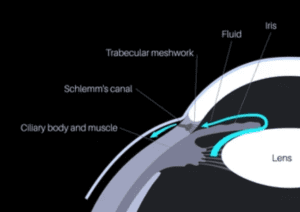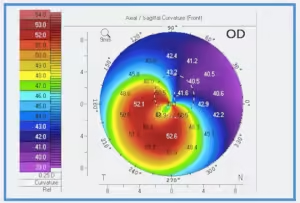Understanding Eye Pressure Numbers – What Do They Actually Mean?

When we talk about glaucoma, the focus often falls on the eye pressure ‘number’. This often leaves people wondering, what does the number actually mean? What if your number is higher or lower than someone else’s? Does that mean you have glaucoma? The reality is, while eye pressure plays a significant role in glaucoma, it is not the sole determinant of the disease. In this blog, we take a look at the complexities of glaucoma, and its multifactorial nature beyond just intraocular pressure numbers.
What is eye pressure?

Your eyes are filled with fluid, and the intraocular pressure (IOP) is the pressure created by the fluid inside your eye. The body automatically maintains IOP by balancing the production and drainage of the aqueous humor (the fluid at the front of the eye). Aqueous humor exits the eye through the drainage angle between the iris and the sclera.
What is normal eye pressure?
Your eyes need a certain amount of pressure inside them to stay healthy. While the typical range of healthy IOP is considered to be 10-20mmHg, eye pressure can vary significantly from person to person. Comparing your eye pressure number with others can be misleading. What might be normal for one person could be too high or low for another. Eye pressure readings can also vary throughout the day, with levels typically being highest in the morning and lowest at night. This can be influenced by factors like posture, physical activity and even caffeine intake.
What causes high eye pressure?
Your body automatically adjusts your eye pressure. Although there are certain factors that can affect your body’s ability to maintain a healthy level, such as:
- Your eyes producing too much aqueous humor
- A blockage or narrowing of the aqueous drainage system
- Eye injuries, and
- Some medications, especially corticosteroids
What is Glaucoma?
Glaucoma is a complex eye condition that causes progressive damage to the optic nerve leading to gradual, permanent vision loss. Damage typically effects the peripheral vision first, and often goes unnoticed until significant loss has occurred.
What is the role of eye pressure in Glaucoma?
Glaucoma is commonly associated with an elevated IOP. If the pressure inside your eye is too high it can compress and damage the delicate fibers of the optic nerve, leading to gradual vision loss and irreversible damage. However the pressure at which nerve damage develops differs from person to person. Not everyone with high eye pressure will develop glaucoma, and not everyone diagnosed with glaucoma will present with high eye pressure.
How is Glaucoma Diagnosed?
While elevated eye pressure is a significant risk factor for glaucoma, other factors such as family history, ethnicity, eye anatomy, age and the appearance of the optic nerve are also considered. Your eye care professional will perform a comprehensive eye examination that includes a detailed family history, eye pressure measurement, optic nerve assessment and visual field testing (an assessment of your peripheral vision). Glaucoma is diagnosed after assessing all risk factors and is not made solely on the eye pressure measurement. If a patient has high eye pressure with no optic nerve damage and no other risk factors for glaucoma, your eye care professional may diagnose ocular hypertension and may recommend regular monitoring without treatment to ensure your eye remains stable.
What is the importance of monitoring eye pressure?
Once Glaucoma is diagnosed, lowering the eye pressure through medications, laser or surgery is the only treatment. This is where the focus shifts to eye pressure readings. Your ophthalmologist may discuss a ‘target’ eye pressure that they believe will slow the progression of optic nerve damage. This is based on the health of your optic nerve and the results of your visual field tests. This target is based on individual results and will be different for each patient. It is important to note that regular reviews to monitor your treatment are important, and your target IOP may change over time depending on how stable your optic nerve appearance is. If damage to the optic nerve continues to worsen, your ophthalmologist may lower your target IOP.
When it comes to eye pressure measurements it is important to remember that there is not one ‘number’ that is normal for all. While eye pressure is an essential factor in the diagnosis of glaucoma, it is not the only consideration. Regular eye examinations are essential for early diagnosis, monitoring and treatment. If you have a family history of glaucoma, or you are concerned about your eye pressure, speak to your eye care professional for further information.



